How to clean the surface of the iron from burnt fabric
Ironing can be challenging, especially for delicate fabrics. The material can stick to the sole, as a result, the thing becomes unusable, the iron needs cleaning. The question of how to clean the burned-in fabric from the iron is considered quite common. Today there are several effective cleaning methods, much depends on the type of iron surface. It should be borne in mind that the loudest promises of iron manufacturers do not come true. The need to clean the sole of the device may be required at any time.
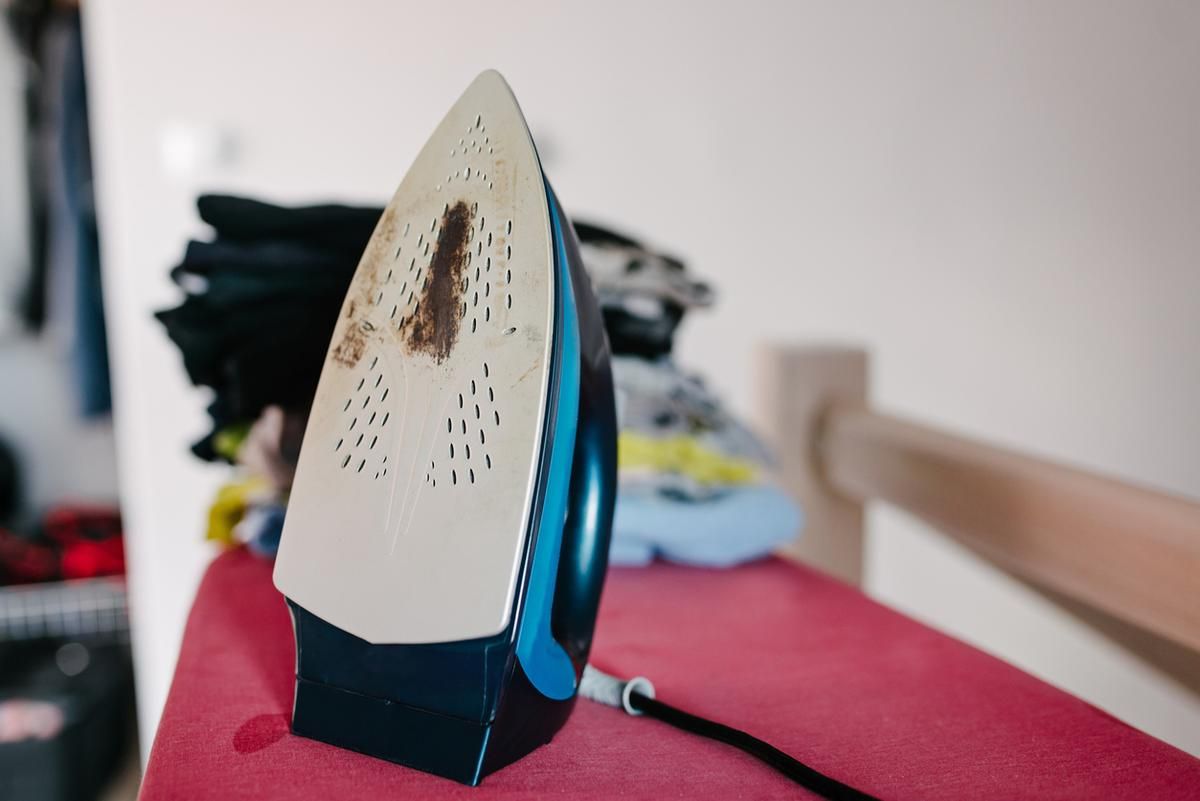
Why does fabric stick to the iron
Failure to comply with them leads to premature wear and damage to things. One of the most common problems is that the fabric sticks to the iron bed. The main difficulty is that the iron is no longer usable. It is not easy to remove pieces of fabric stuck to the iron on your own. Knowing the causes will help prevent the problem.

Causes:
- overexposure of the iron to things - this often happens when attention is distracted;
- sensor malfunction, incorrect display of heating - ironing delicate fabrics at maximum temperature leads to burning;
- the presence of metal, cellophane, plastic, leather fabrics on things;
- violation of the rules for cleaning the surface of the iron - for these purposes it is not recommended to use knives, brushes made of metal, powders for processing kitchen surfaces;
- exceeding the temperature regime - microfibers remain on the sole of the iron, the accumulation of which leads to the formation of carbon deposits;
- the use of low-quality water - limescale in the composition of the water leads to the formation of roughness on the surface of the iron, a decrease in the quality of sliding, the formation of carbon deposits;
- damage to the platform - scratches, microcracks reduce the quality of ironing;
- non-observance of the rules for ironing delicate fabrics.

In most cases, the fabric sticks to the iron when ironing at the wrong temperature. It is recommended to use damp gauze when ironing delicate fabrics.
How to remove stuck fabric from the iron
First, you should know the type of surface of the iron platform, which will help you choose the right cleaning method. The procedure is most often carried out with the iron on, you should worry in advance about the place where the device could be plugged into the outlet. When using special store products, it is recommended to follow the instructions exactly. You will need a soft cloth for cleaning. During the procedure, keep away from the steam holes. Compliance with the listed rules will help prevent possible problems.

Cleaning with vinegar
Vinegar will help get rid of burnt tissue.
Cleaning methods:
- Wipe the platform with a cloth soaked in vinegar — the method is recommended for removing fresh light plaque.
- Put a cloth soaked in a large amount of vinegar under the iron overnight - a method suitable for removing stubborn stains. The acidic liquid will soften and exfoliate the stain. At the final stage, it is recommended to wipe the surface with a dry cloth.

Laundry soap
Laundry soap is recommended to be used immediately after staining. It is recommended to apply laundry soap on the hot sole. A cold iron should be cleaned of traces of dirt.

Salt
Salt is considered the most effective iron cleaner. Its main advantage is accessibility, it is present in every home, without exception.
Recipes:
- Sprinkle ½ tbsp of salt in an even layer, iron the additive with an iron heated to maximum temperature until the stains disappear completely.
- Wrap a handful of salt in a natural cloth, gently apply it to the heated iron until the stains disappear.

Important! It is not recommended to use salt when cleaning the Teflon coating; any abrasive compounds are also prohibited.
Candle paraffin
When cleaning the iron, paraffin wax shows the effectiveness. An ordinary candle is suitable for these purposes. The method allows you to get rid of small dirt, helps in removing plaque of various origins.
Application steps:
- wrap the candle in cotton fabric;
- hold a candle along the heated sole, the molten paraffin will flow down along with the dirt.

A small angle must be observed during the procedure. This will allow the cleaning agent to drain onto the previously prepared rag. At the final stage, it is recommended to wipe the surface with a damp cloth.
In the presence of the "steam" function, the holes on the soleplate of the iron are additionally cleaned. To do this, press the steam supply button several times. The water tank must be filled.

Toothpaste
The toothpaste is suitable for cleaning stainless steel surfaces. To do this, apply the product to a pre-heated sole. The use of an old toothbrush will help to increase the effect, it will allow you to wipe off the carbon deposits. At the final stage, the surface should be wiped with a damp cloth and wiped dry.

Important! When choosing a paste, preference should be given to an ordinary white one without abrasive particles and other inclusions in the composition.
Baking soda
It is recommended to use baking soda when cleaning metal surfaces. The substance is abrasive and caution should be exercised when using it.
Cleaning steps:
- mix soda with water;
- apply the composition on a cold surface for 20 minutes (with old stains);
- gently wipe off the marks with a soft cloth;
- wash off the remnants with a damp sponge.

Important! It is recommended to use soda in cases where other means have proved to be ineffective.
Iron cleaners
In stores, special pencils and liquids are sold, the use of which ensures the rapid removal of dirt, corrosion, scale.
Steps for cleaning the iron with a pencil:
- set the switch to medium temperature, heat the iron;
- wipe the sole with a pencil - the product, upon contact with a hot surface, will melt and drain off with dirt;
- remove traces of fabric with a rag.

Important! Caution is advised when using pencils. The active ingredient is acid. Melting is accompanied by a pungent odor. Avoid getting the product on the skin, as painful burns are formed on contact with it.
Liquid products
When buying, it is recommended to pay attention to the type of surface for which the agent is used. The compositions help to get rid of different types of stains, form a special protective film on the surface of the platform.

Sponges
Sponges help get rid of old stains and limescale. Their use is not recommended when processing polished surfaces, non-stick coatings.
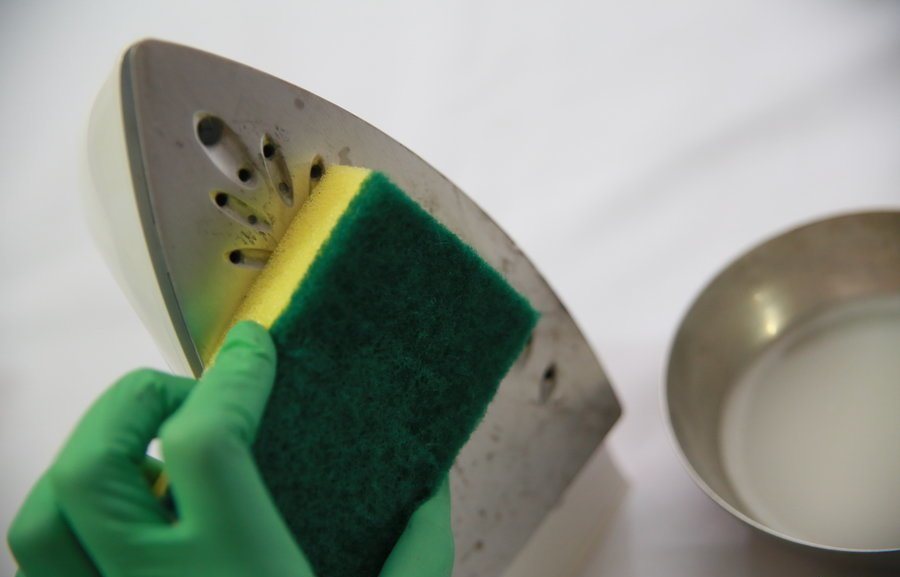
Cleaning mats
The mats can be used to remove burnt-on fabrics and to process all types of platforms. The rug must be installed on the table, place a cold iron on top, and hold it several times. Wipe the surface with a soft cloth, steam self-cleaning.

How to clean different types of coatings
Before choosing a cleaner for the iron, you should find out the material of the platform. This will avoid problems and find the most effective cleaning method.
Teflon
Teflon platform irons are functional. They are suitable for ironing all types of fabrics. Teflon platforms are non-stick coated. The fabric rarely sticks to them, but it still happens. To begin with, it is recommended to wipe the surface with a cloth dampened in water. Under the influence of temperature, the dirt should disappear. When cleaning such surfaces, it is also recommended to use special sponges or pencils. When carrying out the procedure, it is recommended to follow the instructions of the manufacturer. Enough part of the kit includes special scrapers that are designed to clean the surface. If necessary, you can purchase a wooden scraper from the store and use it for the same purposes.

An excellent alternative is the use of vinegar essence. Handling corrosive liquids requires taking precautions. Contact with mucous membranes, skin, there is a risk of burns. It is recommended to soak a small piece of cloth in the essence and wipe the platform with it. If there is no effect, a piece of cloth soaked in the solution must be ironed with an iron.
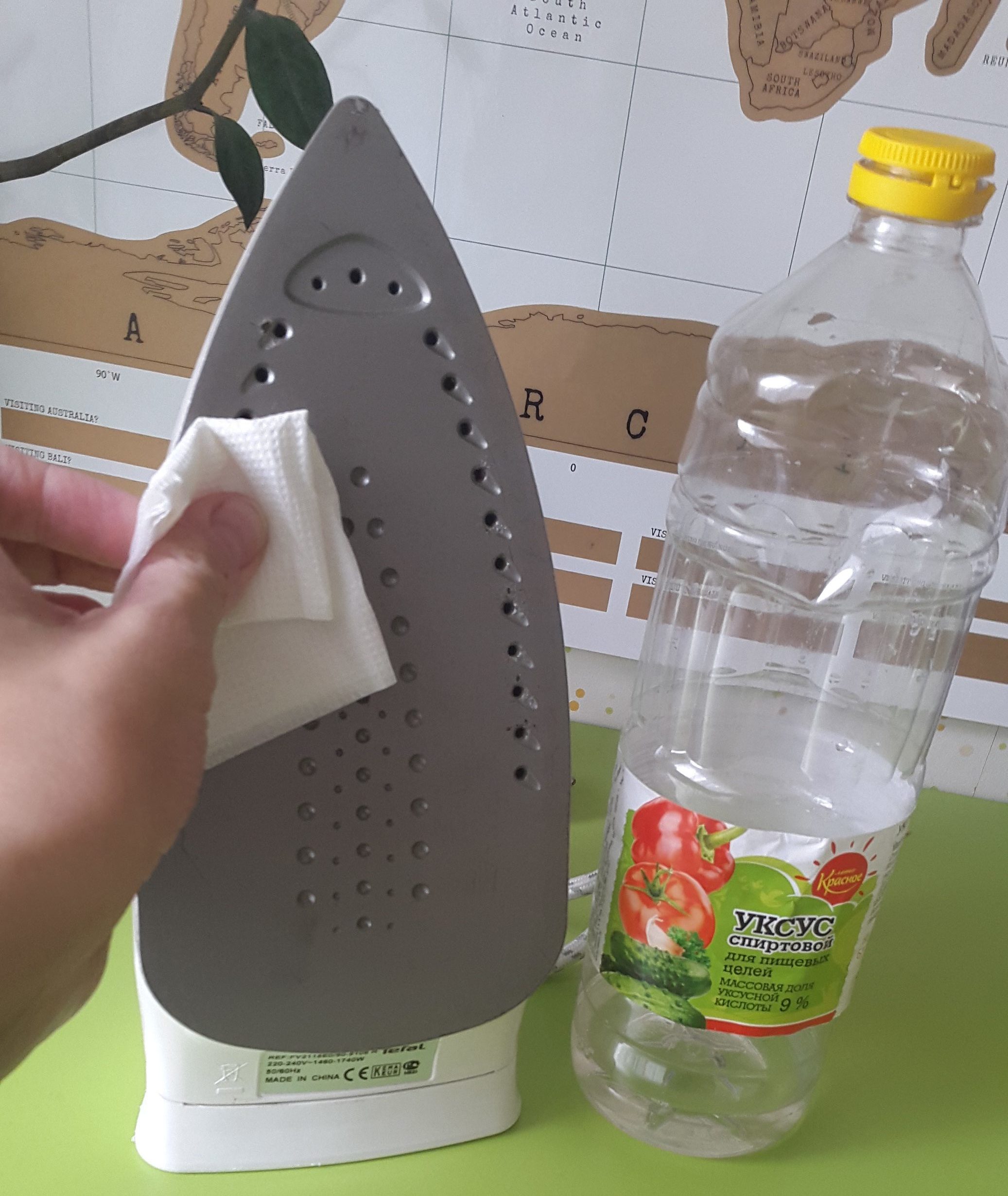
Aluminum
Aluminum is considered the most affordable material. In everyday life, the operation of such an iron is associated with big problems. The platform is susceptible to mechanical damage, carbon deposits and dirt are clogged in them. Advanced types of aluminum are used in modern models, among them anodized aluminum, aluminum with Teflon. The surfaces are non-stick, but they are also not resistant to damage and abrasion.

The use of substances with abrasive particles in the composition in this case is not allowed. When cleaning, it is recommended to use a pencil, vinegar, soft toothpaste, dishwashing liquid. At the final stage, it is recommended to polish the surface.
Ceramic
Ceramic surfaces are susceptible to mechanical damage.The use of abrasives in this case is strictly contraindicated, this will help prevent the formation of scratches, which will cling to the fibers during ironing. To eliminate traces of fabric from such surfaces, care products with glass ceramics and microwave ovens will help.

A special cleaning stick with ammonia in the composition also shows high efficiency. Following the instructions will help you get rid of stains quickly and easily.
Other cleaning methods:
- moisten a cloth in a solution of mixed in equal proportions of ammonia and water, treat the surface with it, repeat the procedure until the dirt is completely removed, the sponge should be soft, not metal;
- use a piece of cloth soaked in hydrogen peroxide to treat the heated surface of the iron; at the final stage, the steam holes are cleaned;
- rub the platform with toilet soap, leave for an hour, wipe off the marks with a damp towel;
- wipe the platform with a cloth dampened with acetone.

Steel
Stainless steel is characterized by increased resistance to mechanical stress. When cleaning such a platform, it is recommended to use baking soda, toothpaste. Efficiency is also shown by the method using a matchbox. It must be picked up and wiped with a sulfur strip over the surface.

Problem prevention
Compliance with the operating rules of the device will help to avoid the formation of stains on the iron platform. Only clean items should be ironed.

Recommendations:
- wiping the platform with a damp cloth after ironing;
- periodic cleaning of the device from the inside of the scale;
- the correct choice of ironing mode, depending on the type of fabric;
- avoiding the use of metal brushes and sponges, after which scratches form on the surface;
- cleaning the tank from water residues after ironing - will help slow down the formation of scale and corrosion.
It is recommended to take precautions when ironing. The iron should not be left switched on unattended, use it with a damaged cable, and avoid touching a heated surface.
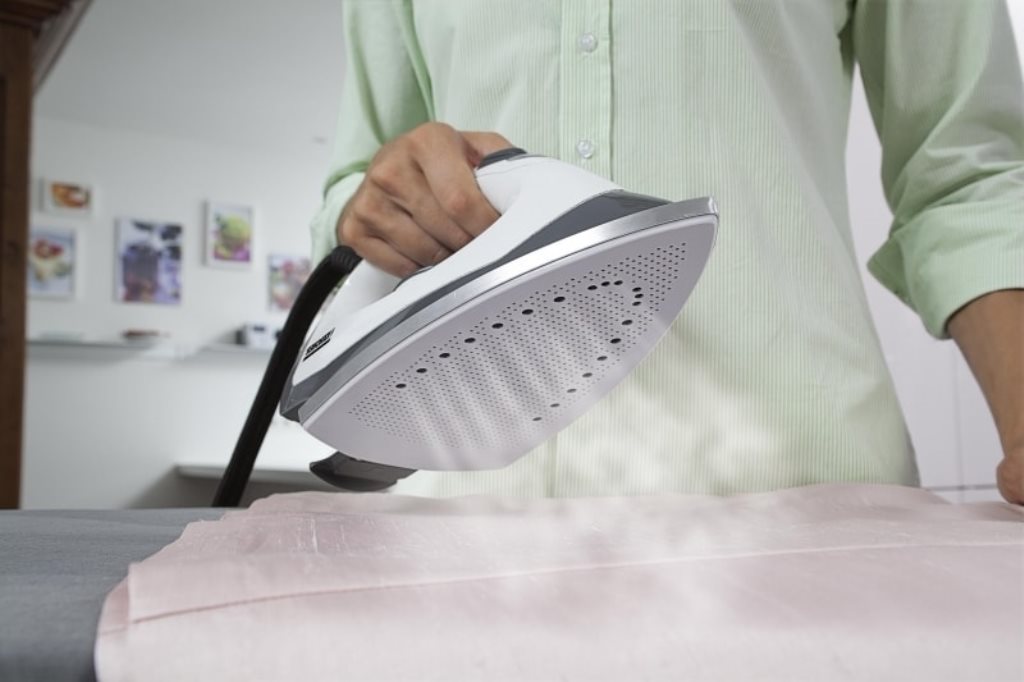
If there is a large number of things, they are pre-sorted. It is recommended to start with delicate fabrics that are processed at low temperatures.

Ironing rules for different types of fabrics:
- flax - it is recommended to iron in a wet state at a temperature of 180-220 degrees from the wrong side;
- cotton - 180 degrees is considered the optimal temperature, it is recommended to moisten the fabric during ironing;
- polyester - 110 degrees is considered the norm, special attention should be paid to ironing patterns, embroidery (the procedure should be carried out through gauze from the inside out);
- silk - the fabric should be ironed at 60-80 degrees with the steam function turned off, any material should be placed between the iron and the thing, with the exception of gauze;
- wool - processing is carried out at 120 degrees, a damp cotton cloth will help prevent the material from sticking to the iron;
- viscose - it is recommended to iron the fabric only from the seamy side at 110-120 degrees, it is not recommended to turn on the steam function;
- chintz - the optimal mode is 150-170 degrees, ironing is carried out from the front side.

VIDEO: How to clean the iron from burnt fabric.


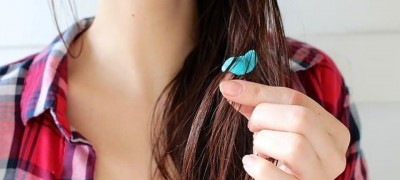



Discussions
Thank you very much for the good advice.